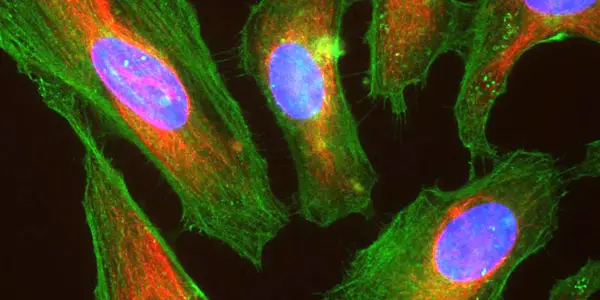Fantasy Science Pt.7: Immortality & THE MAN FROM EARTH

Radha has a PhD in theoretical quantum physics. Apart from…
Immortality. Regeneration. Stem Cells. Have you heard terms like these flying around the science fiction sections of the film world? Have you ever wondered just how accurately these films portray real science? Well, my friends, today is your lucky day: this column, Fantasy Science & Coffee aims to bridge the gap between science and science fiction in films and, occasionally, popular culture. My hope is to explain things in a fun way – like we’re chatting over coffee.
You may be thinking: who is this person, why does she think she can explain science, and why the heck would I want to have coffee with her? Well, I’m Radha, a researcher in India, currently pursuing a PhD in theoretical quantum physics. I quite like hot beverages. I’ll also pay.

In this seventh part of the series published on the second and fourth Tuesdays of every month, we are going to chat about naturally occurring biological immortality.
Let’s begin.
Immortality
The obsession with life extension and immortality does not lie solely within the realms of science fiction: one of the driving forces of medical research throughout history has been to prolong life. There are a number of ways this has been attempted both in reality and in science fiction, from triggering certain biological processes to using bionics as biological replacements. To go into each will require a number of those coffees I promised you, so for now, we will focus on one type: biological immortality that has not been artificially stimulated.
A beautiful film that focuses on just this is The Man from Earth. Rather than being affected by medical advances, the protagonist is simply a man who was born about 14,000 years ago and has not aged beyond 35 years.

John Oldman — pun very likely intended — is a history professor, who claims to his colleagues that he’s been around since what he believes to be the upper Paleolithic period, making him a Cro-Magnon.
Naturally, his colleagues don’t believe him, but as a group of esteemed professors in biology, archaeology, anthropology, and psychiatry, they are intrigued by the intellectual nature of his story. They ‘play along’, and contemplate how this immortal caveman could theoretically be possible.
Their suggestion was that the immortal’s body undergoes perfect cellular regeneration and detoxification. This would mean that not only does John recover from wounds, but that he would recover from fatal illnesses as well, which he later affirmed:
The suggestion is not misplaced; there really are biological processes that nod to these claims, particularly regeneration. Biological immortality as such isn’t really fiction – it does manifest in real life in certain ways! There aren’t any cavemen walking around that are thousands of years old – that we know of! – but there are a few fascinating natural phenomena that nod towards immortality. Let’s look at a few of them.
Regeneration through Stem Cells
You may recall that the character, Harry, suggested that John Oldman has a plethora of stem cells that are constantly renewing organs and repairing damage in his body. This isn’t far from the truth at all.
Stem cells are ‘undifferentiated’ cells, that is, cells that have as yet to develop into a particular type of cell. This makes them powerful natural tools for regeneration. Adult stem cells lie within our tissues and organs, waiting to be ‘triggered’ when needed to repair damage caused by an injury or a disease. They also play a part in what is called homeostatic maintenance, a process that keeps our organs healthy through renewal.
So, we naturally have these little regeneration machines in our bodies, even though they don’t work as amazingly as those in John’s body. It is no wonder that medical research targets these powerful biological tools – there are already stem cell therapies and trials available out there! The hope is to artificially activate stem cells for repair, and potentially eradicate diseases like cancer. This artificial process is beyond the scope of this article, but there are a few links I’ve added at the end that you may explore to learn about the type of research that’s happening in this field.
‘Immortality’ in Certain Animals

While humans are faced with aging issues, and our stem cell regeneration is far from being superhero-like, there actually are a few animals out there that display abilities seemingly straight out of science fiction. They aren’t truly immortal, but heck, they’re better off than humans are!
Some lizard species, for instance, can shed their tail at will to confuse a predator, only to regrow their tail back later. Lobsters shed and regrow their exoskeletons, with no set limit on how big they get. Turtles shed scutes to give way for bigger ones as their shells grow.
Turtles and lobsters, in particular, are sometimes claimed to be ‘immortal’ because they display negligible senescence. That is, they have an absence of aging symptoms as they grow older. What causes the death of these creatures isn’t really old age but illness or accidents. Lobsters, for instance, reproduce right up to the end, and only die when the process of shedding their exoskeletons becomes too exhausting.
Cell Line Immortality

Apart from a few animals that display negligible senescence, there is biological immortality at a cellular level for cells that do not hit the Hayflick limit – the maximum number of times a normal human cell can divide. There exist immortal cell lines that circumvent this limit. The first of these was the HeLa cancer cell line, originating from an African American woman named Henrietta Lacks.
With immortal cell lines, researchers can repeatedly experiment with treatments, giving rise to new vaccines and cures. Modern medicine is actually where it is because of HeLa cells; for instance, the vaccines for polio and HPV directly arose due to experimentation with the HeLa line.
As mentioned, the special thing about these immortal cells is that they do not succumb to the Hayflick limit. Usually, cells taken from the body die through a process called apoptosis. Due to a combination of factors, however, HeLa cells can divide indefinitely. Some scientists actually view them as a new species of unicellular organisms, close to but not quite human.
Nowadays, an immortal cell line is either created through genetic engineering, or discovered by chance in much the same way Lacks’ was. To learn more about the woman behind the cell line, check out the book The Immortal Life by Henrietta Lacks, and the 2017 film by the same name.
We’ve talked a bit about naturally occurring biological immortality with respect to the story of the film The Man from Earth. What are some other means of immortality, both natural and artificial, that you have spotted across science fiction?
More to Explore
Online Resources
Ageless Animals – a project studying negligible senescence in animals
Articles
Inverse.Com: The Science Behind Henrietta Lacks’ Immortal Cells (2017)
Medical News Today: What are Stem Cells? (2017)
HowStuffWorks: Can a turtle outgrow its shell?
Huffington Post: Scientists Have Figured Out How Lizards Regrow Their Tails, And That’s Good News For Humans (2014)
Smithsonian: Don’t Listen to the Buzz: Lobsters Aren’t Actually Immortal (2013)
Harvard Stem Cell Institute: The Seeds of Regeneration (2008)
Discover: No Longer Human (1992)
Papers
Emerging Area of Aging Research: Long‐Lived Animals with “Negligible Senescence”, Annals of the New York Academy of Sciences (2006) (full text can be found on the Ageless Animals website )
Books
The Immortal Life of Henrietta Lacks by Rebecca Skloot
Does content like this matter to you?
Become a Member and support film journalism. Unlock access to all of Film Inquiry`s great articles. Join a community of like-minded readers who are passionate about cinema - get access to our private members Network, give back to independent filmmakers, and more.
Radha has a PhD in theoretical quantum physics. Apart from research, she consults on sci-fi screenplays/books. In her free time, she cosplays and irritates her three cats. Bug her on Twitter: @RadhaPyari
















